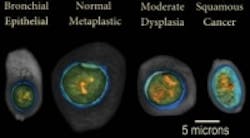Five ways vision systems improved lives in 2013
Throughout the course of 2013, we covered a vast number of vision system applications across a multitude of topics. In many ways, these vision systems helped to improve lives, whether it is something as simple as making someone’s job easier or safer, or working to advance the capabilities of cancer detection in medical imaging devices.
Regardless of how you measure each "improvement," it is safe to say that these vision systems provided a valuable service this year.
1. 3D imaging and analysis software detects lung cancer in sputum cells
VisionGate’s Cell-CT platform creates 3D images of sample cells from sputum collected from lung cancer patients and healthy patients, and uses advanced algorithms and image analysis software to make a cell-based diagnostic approach. Concerning how this improves one’s life, the concept of cancer detection speaks for itself.
2. Robots, UAVs used to photograph lions in the wild
Photographer Michael “Nick” Nichols used infrared photography, unmanned aerial vehicles (UAV), and vision-enabled robots to capture never-before-seen images of lions in the wild for the August issue of National Geographic. How did this improve Nichols’ life? Well, he’s still alive, isn’t he?
3. Laser imaging technique shows surgeons where tumors are in the brain
Using a technique called stimulated Raman scattering (SRS) microscopy, a team of researchers from Harvard University and the University of Michigan were able to build images which enabled them to distinguish between microscopic areas of tumor cells and healthy tissue in the brains of mice. The method used in this study would provide a more efficient and accurate way of detecting the location of a tumor in a brain.
4. Augmented vision system aids the sight impaired
In the past, people suffering from age-related macular degeneration (AMD), glaucoma and retinopathy relied on guide dogs and white canes to assist them. Today, however, researchers are aiming to develop novel methods such as retinal implants and augmented vision systems to increase the visual acuity of blind people. Goes without saying, really, but providing or enhancing vision for those in need would provide a great quality of life improvement.
5. Underwater robots search for World War II pilots, aircraft
The BentProp Project, which aims to locate, identify, and repatriate the remains of U.S. service members killed, and listed as still missing, in action in the Republic of Palau during World War II, is using autonomous underwater vehicles to locate sunken aircraft. The robots utilized in this project took divers out of a potentially dangerous situation as well as sped up the process by a drastically significant amount of time.
Share your vision-related news by contacting James Carroll, Senior Web Editor, Vision Systems Design
To receive news like this in your inbox, click here.
About the Author

James Carroll
Former VSD Editor James Carroll joined the team 2013. Carroll covered machine vision and imaging from numerous angles, including application stories, industry news, market updates, and new products. In addition to writing and editing articles, Carroll managed the Innovators Awards program and webcasts.
